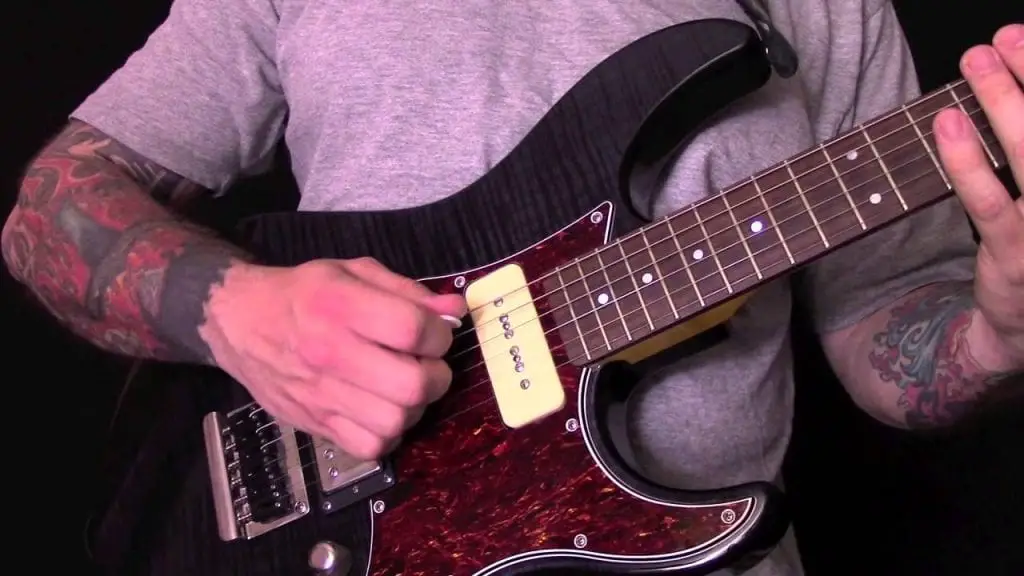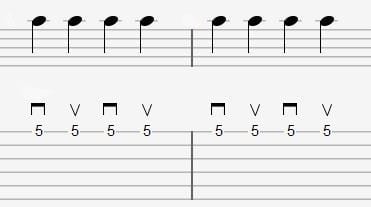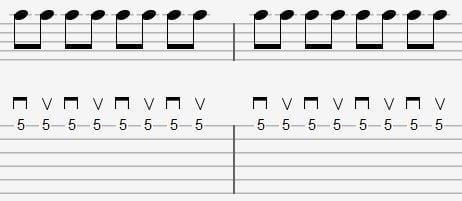Tremolo Picking is a type of alternate picking, performed typically at a rapid speed while focusing on a single note over a set duration. It is regarded as an advanced technique that requires practice and discipline to master. This technique can be achieved on any type of guitar, whether electric or acoustic, with the fingers, or using a plectrum.
Getting Started
When doing tremolo picking, make sure that your picking arm stays relaxed. If your arm is tense, you may end up encountering fatigue issues as you try to push the picking speed. As you start developing your ability in tremolo picking, the next thing that you need to focus on is the precision of your notes, while achieving an even note length across a specific time range.
One pitfall that many encounters are rushing into an attempt to increase the speed before the technique is mastered to muscle memory. This can present some issues, such as arm fatigue and inconsistent note lengths.
In order to avoid these, it is important to master tremolo picking, performing exercises, which will help you build up on your picking stamina and fluency that will enable you to do tremolo picking consistently.
How to Master Tremolo Picking

Just like with other techniques, it is important to start slow and relaxed with tremolo picking. After all, you may have attempted it but observed that it is not working for you. The reason? It could be that you have not practiced it the right way.
You may have tried skipping ahead to faster speeds, jumping into more difficult tremolo picking forms without properly laying the right foundation for the more challenging stages of this technique. A good rule of the thumb is to avoid starting with moderately high speeds, as well as 16th note sequences
Set the Foundation – Alternate Picking
Before you head with tremolo picking, you can start with its firm prerequisite – alternative picking. If you do not get it right, most likely, you will also find tremolo picking almost impossible to do. As such, before doing anything, it is best to set the foundation by understanding and to learn more about this basic technique.
Alternate picking refers to picking a note on the guitar using two opportunities in hitting the string – upstroke (on the way up) and a downstroke (on the way down).
Why is it important to understand this? Some inexperienced players have the tendency to the downstroke, and then bringing their hands above the string before starting to do the downstroke picking again.
For obvious reasons, this is quite problematic. You could end up playing more notes without any additional movement. This can be solved by alternate picking. True to its name, alternate picking means picking the note using the downstroke and then an upstroke for the next note.
If it is your first time to do alternative picking, it may be challenging at first. The movement of your fingers may feel somewhat awkward. The good news is that it will not take long for your right hand to properly acclimate.
When you finally get the technique to muscle memory, you can already use it to start practicing on your tremolo picking.
The Best Way to Start – Quarter Notes
Most of the time, tremolo picking is used for handling both 8th and 16th notes. You can even handle 32nd notes for advanced speeds. To start practicing, it is best to start with quarter notes while making repetitive, mind-numbing patterns. Even though the speed in each type of note may vary depending on BPMs, this will provide you with an easy way to show time on a music sheet.
Until you finally get to the 16th notes, you can assume that all of the tabs are around 120 bpm. You can practice a score using the very same repetitive picking movement that you do with alternate picking.
If you are now ready to take the difficulty level up, you can use the same pattern of the quarter note divided into a chromatic sequence. At this point, you will notice that there is little difference between alternate and tremolo picking.
A benefit that you will achieve while practicing this way is that being intentional in using the quarter note timing requires you to practice a highly rigid consistency in tremolo picking. This means that your right hand will get used to the motion, preparing you for higher speeds.
Doing tremolo picking on a single string is something that you may want to familiarize and use often. Transferring from one string to another only adds to the difficulty and complexity of the procedure. This can be focused on when you are already comfortable with tremolo picking on a single string.
It is important to understand that when it comes to tremolo picking, timing is as important as the speed. It is in contrast with alternate picking wherein timing is not really a requirement.
The Next Level – Eighth Notes
To start tremolo picking on eighth notes, you need to stay on the same string as you simplify the tab. At this point, it is vital to keep the fret changes minimal, while focusing on your right hand’s consistency, especially because it will do most of the heavy lifting. You are still at 120 bpm while doing this.
The goal here is to create a consistent tempo while keeping the speed low. This pattern can also be moved around to different strings and frets. For practicing tremolo picking, it is usually the third and fourth string runs, which are the easiest, mainly because of the ideal size of the string.
After being comfortable with this pattern, you can then move up to something that is broken up on the second and third strings.
If you are interested in adding more notes to the run of an eighth note, a rule of thumb is to do two tones for every measure. This means that the first four notes in a measure will be counted as one tone, and a different tone for the second four.
Moving Up – Sixteenth Notes
At first, using the sixteenth notes seem challenging at first. The good thing, though, is that they are not impossible to achieve, even with an understandably slow speed. With the sixteenth notes, experts recommend starting with around 80 bpm.
80 bpm is already slow, and it makes the measures of the sixteenth note manageable. This is great for practicing. You can also take things a notch higher by adding some complexity. You can either increase the bpm or make the tab even more challenging.
You can further expand on this pattern, even to the point of challenging yourself in the same way that you did with both quarter and eight-note patterns. Once you are already comfortable, you can up the speed.
If you feel that that you are not capable of keeping up with a consistent rhythm, it is already a signal that you may need to slow down again. As you notice your consistency and timing improving, speed will also become easier, and you are on the right path when it comes to becoming highly effective in tremolo picking.
Tremolo Picking Exercises

The following exercises for tremolo picking will help you in building up your stamina and fluency in picking, thus allowing you to do tremolo picking consistency.
Note that all of these exercises were designed to work together with a metronome. Just like with other practices that use a metronome, it is important to start slow and increasing the tempo slowly as you become more comfortable and proficient with this technique.
Exercise 1

This exercise is one that is very slow. It is designed to reinforce the consistency of up and down picking movements. As you try to start tremolo picking, you will observe that you will become comfortable with the alternate picking movement. On the other hand, if you feel that alternate picking is something that needs focus, then this is a good place to start.
This exercise uses quarter notes. This means that every note will fall on a single beat. When using a metronome with this exercise, you can set the metronome to a tempo that is comfortable for you, allowing you to alternate pick with one note for every beat.
You can then do downstrokes on beats 1 and 3, and upstrokes for 2 and 4. After this technique starts flowing in comfortably, you can then increase the tempo of the metronome slowly.
Exercise 2

This exercise is designed to break the beat down into sub-divisions. Rather than playing the crotches on the beat, it gets split into eighth notes. This means that you will now hit two notes for every beat. By doing so, the “and” in between the beats is produced.
This new note that exists in between the beats now changes the pattern for alternate picking. The downstrokes will fall on every beat, while the upstrokes will fall on the “and” for every beat.
As you use a metronome for this exercise, it is important to hit two consistent and clear notes for every beat. You can do so by starting at a comfortable and slower pace, allowing you to split the beat easily while working the tempo up the moment you become comfortable.
If you match the tempo together with the previous exercise, it will feel twice as fast since you will now be picking twice as many notes with the same number of beats. If you focus on your accuracy and consistency, you may find this exercise easier to accomplish at a slower tempo than the previous one. Afterward, you can increase the speed higher after cleaning up the technique.
Other Factors to Consider
Before you eventually become a master in tremolo picking, it is expected that you will deal with some challenges along the way. In fact, nobody becomes an expert without going through some trial and error experiences.
There are things that you can anticipate early on. This includes some soreness and fatigue, especially in the wrist and the elbow joints of your right arm.
Some of these annoying issues are unavoidable, but will certainly go away along with continued practice.
To help you deal with these challenges, there are things that you can do.
Avoid tense on the forearm
You will notice your forearm naturally tensing up, particularly when you attempt to pick up at higher speeds. Avoid this reflex of your forearm as much as possible in order to lessen the soreness.
Use your wrist well
Most movements required for tremolo picking comes from the wrist joints, not on the elbow. As such, make sure that your wrists are used well.
Stay on the safe side
True, it is important to challenge yourself in order to improve. However, it is even more effective to play within the speed in which you are comfortable, even though it seems very easy for you. As a matter of fact, it would be faster for you to become better in tremolo picking if you spend your time practicing below your threshold in speed.
Fingerstyle, picking, and thickness
It is very important to understand that thicker picks are usually more stubborn for tremolo picking. It may work better and easier for you to use a thin or medium pick for early practice sessions, as they are somewhat more forgiving than thicker ones.
The flimsiness of thin picks will work better for the fastback and forth movement of the strings. There are some who find it easier to do tremolo picking when using their own fingers.
Whether you are to use a pick or your fingers, it is totally up to you. You may want to experiment with both of these options and see which approach works best for you. If you end up choosing the pick, you may want to start with something light, and eventually working your way up in terms of thickness.



